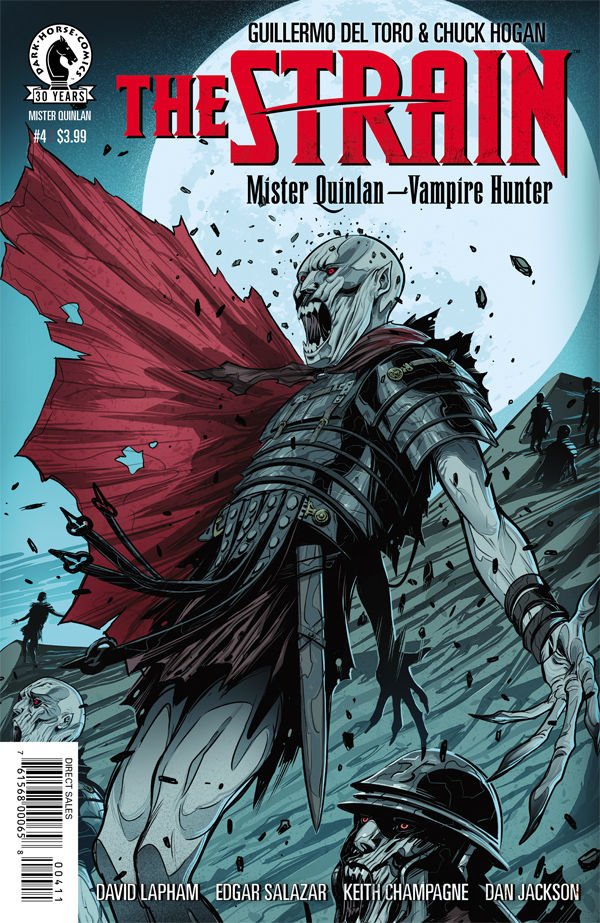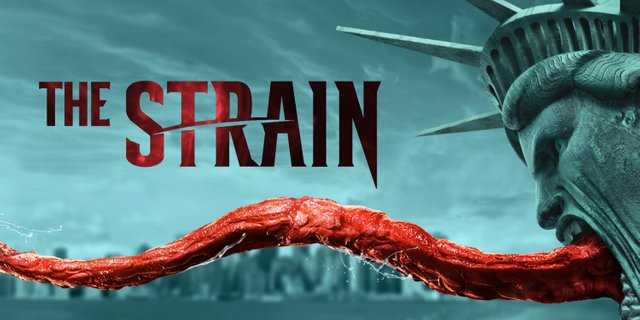The Strain, The Vampire New Version

Concept of vampires is mainly built by Dracula's novel by Bram Stoker. The vampire is depicted as a black-robed figure resembling a bat, has a canine to suck blood from its victims, fearing the sun so it only appears at night, has a telepathy capable of hypnotizing the victim, and usually resides in remote castles. The portrayal of vampires as a scary evil creature was then completely overhauled when Stephanie Meyer wrote a horrendous Twillight series in the early 2000s. Meyer-style vampires are amazingly beautiful / handsome figures but wear talc (pale, sorry), have super powers, immortals, and young forever. The vampire type of dream desires. The nature of vampires as dark creatures dimmed slightly.
Later, Del Toro and Chuck Hogan emerged with the trilogy of The Strain that restored the vampires' position as evil beings. The difference with Stoker, these two modern writers combine superstition and science fiction in The Strain-perhaps a bit of alien scent. Vampires are no longer depicted as a handsome / pale figure, but a vicious creature resembling a zombie. Someone turns into a vampire when there is a kind of mysterious strain of virus in the body of a type of blood worm entering into his body. These bloodworms come in when the victim is bitten, or in this case pierced by a kind of stinger hidden under the mouth. So, in this novel, vampires do not bite, but sting.
The process of turning into a vampire in The Strain is described in such detail and painful, more like a disease infection process in the body. At first, the blood worms will enter the bloodstream, eating the victim's fresh blood. The virus will then destroy the body's proteins and slowly and painfully, turning the host's body into new vampires. The virus will eventually overwhelm the body of the victim, making it a complete vampire with a new stinger mechanism and horrible capillary worms circulating all over his body. Ready to transmit the vampire virus to those around him. Even more intimidating, the stinger could extend up to two meters and be able to cut the victim at high speed.

One thing that makes The Strain exciting is the way the author tells the process of spreading the virus. Beginning with getting a plane containing 200 passengers at New York Airport. All the passengers died soon after they got, leaving 4 survivors with strange diseases. No one knows what happened. Dr. Eph Goodweather and his colleagues are the few people who first noticed this oddity. No gas leak, terrorist attack, or aircraft damage; but more than 200 people were killed in their seats. In this confusion, Dr. Eph was met with an elderly shopkeeper named Sentrakian. This man desperately told Eph that the dead passengers would rise again at night. But it was too late.
At night after the solar eclipse, the corpses bounced back with a blood-worming virus and a stinger. Each returns to his home, searches for the victims of the people closest, and then further spread the vampire virus. New York fell into chaos within a week. This part is what I think is the most scary. The Strain describes how the vampires returned home and targeted their victims. From one scene to another, this chapter is like we're watching the living corpses coming in and actually in the kitchen, in the bedroom, in the bathroom, and on the street front. Incredibly creepy. The longer. The vampires are also more agile in the move, especially if they have drunk the blood of the victim. This part is genuine real gore!
Though it is a science fiction thriller, unfortunately the superstitious aspect still has a large portion in this novel. Like the ancient vampire tradition, the vampires in The Strain also can not stand the sun and silver. They can indeed enter the house uninvited and immune from holy water or the cross symbol, but silver poison their bodies while UV rays burn their bodies. It is also depicted in The Strain that these vampires can not pass through the flowing water. In the end, the heroes in this novel must use a variety of silver weapons to defeat hordes of blood-thirsty vampires. Here the reader may remember the struggle of Buffy the Vampire Slayer and his gang.
This mixture of superstitions and science fiction that might make this great series feel a burden for some readers. I have not been able to find a reason why viruses are weak because of silver metal, but not for other metals. They can be decapitated easily through silver swords but can still move even though their heads are shot with tin bullets. For the deadly UV light is still acceptable because some disease viruses can die sata exposed to sunlight. Still, seeing these vampires decay into dust when exposed to sunlight brings us to the old vampire myth that burns in the sun. If there is a little scientific explanation for this case of silver and UV rays, maybe this series can get a 4 star at Goodreads.
But beyond that lack, this novel is creepy, makes you tick, and makes you curious. Worth a try to read for thriller story buffs.